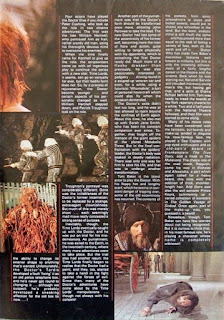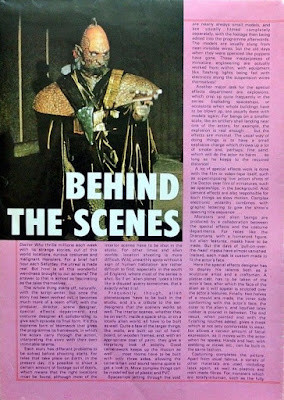Synopsis:
As time corrects itself, the Doctor announces that they have now properly arrived...
They can now be seen by the people who run this museum - the ones who will kill them and place them on display if they capture them. Outside, the TARDIS is already discovered by the white uniformed guards.
Nearby, the Governor in charge of the complex - Lobos - is bemoaning the lack of interest in the museum by his people. They are the warlike Moroks, who once had a great empire. They invaded this planet - Xeros - a generation ago and established the museum to celebrate their many military victories. Now, the Moroks have lost their thirst for conquest. Lobos looks forward to finally getting back home, but still has many months before that can happen. He is notified of the strange craft which has arrived unannounced on Xeros, and orders his men to seek out its occupants and capture them.
A new exhibit may rekindle interest in his museum.
The Doctor and his companions decide to make for the TARDIS, but soon find they are lost in the labyrinth of corridors. Ian decides to remove a futuristic weapon from its display case, if only to use it to threaten.
Elsewhere, the young men in black previously seen by the travellers are meeting in a disused storeroom. Their leader is Tor, and he and his friends are Xeron natives. When the Moroks invaded, they killed all the adults but spared the children. When they grow older, they are shipped off to work as slave labour elsewhere in the empire. Believing that the new arrivals may be in a position to help them, Tor sends Dako and Sita out to find them and bring them to him.
He leads a resistance movement, but they lack the weapons to overthrow Lobos and his men.
The Doctor lags behind the others and is grabbed by the Xeron youths. He feigns unconsciousness until left alone with only Dako then overpowers him. When the rest of the Xerons return they find he has vanished. He is actually hiding in the empty Dalek shell.
So pleased is he with his ruse that he fails to notice a pair of Morok soldiers, who capture him and march him away.
The others argue about what they should do. Will their actions take them away from the display cases - or bring them closer to that fate? Ian unpicks Barbara's cardigan to use the wool as a trail so they won't go round in circles. They finally reach the main doors - only to see the TARDIS just outside under armed guard.
In Lobos' office, the Doctor finds himself trapped in a strange chair. Lobos informs him that it allows him to see images from the Doctor's mind - a means to locate the others and find out who they are. The Doctor realises that the device can be easily fooled - showing the Governor nonsensical images.
Frustrated, Lobos orders that he be taken away for processing...
Next episode: The Search
Data:
Written by: Glyn Jones
Recorded: Friday 9th April 1965 - Television Centre Studio TC4
First broadcast: 5:50pm, Saturday 1st May 1965
Ratings: 9.2 million / AI 53
Designer: Spencer Chapman
Director: Mervyn Pinfield
Guest cast: Richard Shaw (Lobos), Jeremy Bulloch (Tor), Peter Craze (Dako), Peter Sanders (Sita), Peter Diamond (Morok Technician), Salvin Stewart (Morok Messenger)
Critique:Stop me if you've heard this before, but there is an old joke that says that there are only three things wrong with The Space Museum. Those are Episode 2, Episode 3, and Episode 4...
It's at least the third time I've used this gag on this blog, and I didn't even come up with it.
To be honest, this isn't entirely fair, though the opening instalment is undeniably far superior to what follows. The science fiction mystery of jumping time-tracks and glimpsing potential futures was fascinating - the first time that the series had really made time travel an important plot point and not just the thing that gets the Doctor and his companions into the adventure at the beginning of Episode 1, then away again at the end of the last episode.
From its beginnings, Doctor Who was to have told three different types of story: those set in the past, those set in the future / on another world, and those termed "sideways".
This latter was described as stories which explored different states of being. To date only two stories had fitted this category - The Edge of Destruction and Planet of Giants.
The Space Museum (i.e. the episode) also fitted the bill, but the same can't be said of the rest of the story for it is as conventional as they come.
From halfway through The Dimensions of Time, the story takes a turn to the predictable, as it morphs into a typical capture / escape tale with lots of running down corridors.
I say halfway, because first of all we get the lovely scenes between the Doctor and Governor Lobos, as the latter attempts to interrogate the former.
The Morok leader relies on his technology to tell him all he wants to know. He has little or no imagination, whereas the Doctor has this in abundance. He uses it to baffle Lobos by making his mind-reading machine show whatever the Doctor wants it to show. Amongst other bizarre images, we are treated to the sight of the Doctor in Edwardian bathing costume after Lobos insists he is not an amphibian - the Doctor having claimed to come from a rock in the sea covered in walruses.
When Ian, Barbara and Vicki are seen on the device at a particular location, it simply doesn't dawn on Lobos that that was where the Doctor last saw them ages ago, and they would almost certainly have moved on by now.
We also get the almost iconic scene of the Doctor making use of one of his deadliest enemies to outwit his latest foes - chuckling to himself as he emerges from a Dalek casing.
Without doubt, Hartnell is the best thing about The Dimensions of Time.
The opening scene with Lobos, on the other hand, is a prime example of how not to deliver exposition.
He sits at his desk and explains all about the museum, how long he has been there, how long he still has to stay, why no-one seems to be visiting, who the Xeron youths are and why they're rebelling...
He's a Morok, talking to another Morok, yet they both feel the need to explain what their own time units are, and where they come from:
- LOBOS: "Well, I've got two more minims before I go home. Yes, I say it often enough, but it's still two thousand Xeron days...".
- LOBOS (on being told a ship has landed): "From home? There was no advance notification".
- MESSENGER: "Not from the planet Morok. Alien".
The Xerons were originally going to be called the Tarkans, but people struggled with pronouncing this. The Moroks derived their name from "morons", as they were deliberately scripted to be rather dim-witted, unimaginative soldiers. Likewise, Lobos was named after the process of lobotomy - a surgical technique that can leave people "zombified".
The Moroks are given white uniforms, with big shoulders, and their hair is styled in a large quiff.
The Xerons, on the other hand dress in trendy black polo necks and jeans. They have more conventional hairstyles and they have distinctive double-eyebrows.
The Moroks might be styled on the Teddy Boys or Rockers, representing the 1950's, making the Xerons the cooler, more up to date, Hipsters - more likely to be into jazz than rock'n'roll. It's significant that they are all teenagers. The conflict between the Xerons and the Moroks is as much a generational / cultural one as anything else.
There is much discussion between the TARDIS crew as to Ian's missing button. Had they noticed it when in the display cabinets they might have known if the future had been altered. What they neglect to think about about is the more obvious destruction of Barbara's cardigan. She is wearing it in the case, so they have altered the future - even if they don't know to what extent.
There is an unseen pre-Totters Lane adventure mentioned, when the Doctor states that he was with Scottish inventor James Watt when he realised that steam could be harnessed as an efficient power source. This suggests that he was in Glasgow in the early 1770's.
He often takes the credit for inventions and discoveries, but in this instance simply states that he was with Watt.
Trivia:- After their rally last week, the ratings drop by more than a million, but the AI actually rises two points.
- The episode began 10 minutes later than usual due to Bank Holiday sporting events, covered by the BBC's Grandstand programme. The BBC had broadcast the FA Cup Final live that afternoon.
- This is one of the shortest ever episodes, with a running time of only 22 minutes.
- It was cleared for wiping on 31st January 1969, but a film copy was found to have been retained by the BBC in 1977.
- Jeremy Bulloch will become best known for playing bounty hunter Boba Fett in the original Star Wars trilogy. He returned to Doctor Who in 1974 to play archer Hal in The Time Warrior - a role which led to him being briefly considered as a potential companion.
- Richard Shaw will return to the series in Frontier in Space as lunar prison trustee Cross, and in Underworld as one of the cyborg Seers.
- Peter Craze will return in The War Games, as French soldier Du Pont, and again in Nightmare of Eden, as Azure customs officer Costa. He was the brother of Michael Craze - future companion Ben Jackson.
- Peter Diamond was employed both to play the Morok technician and to arrange the action sequences. He had only recently played Ian's friend Delos in The Romans.
- Following the recording of this episode, Hartnell embarked on a week's holiday. He would be absent from The Search.








































